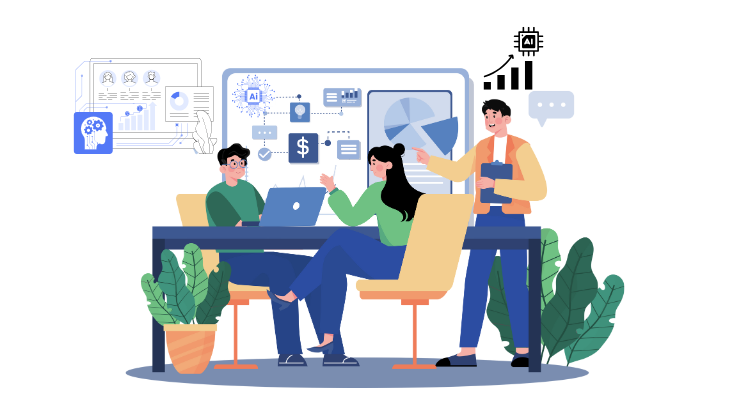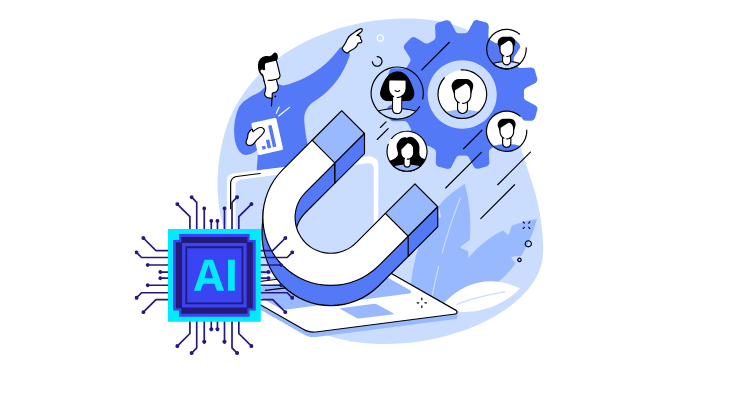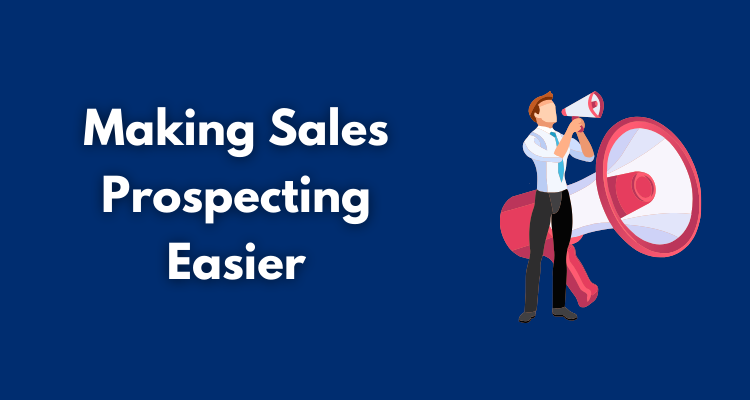Remember when sales prospecting meant spending hours on the phone and keeping track of everything in messy spreadsheets? Those days are pretty much over. Now we’ve got AI and automation tools that make finding and reaching out to leads way faster and smarter.
These tools help sales teams stop wasting time, focus on the right actions, and actually close more deals. McKinsey found that AI can slash lead costs by up to 45% and make sales teams 30% more productive. We’re going to show you how AI and automation are completely changing the prospecting game.
You will see real examples and easy tips for anyone in B2B sales, startup founders, or people trying to grow their business.
Table of Contents
ToggleHow AI Is Changing Sales Prospecting

Gone are the days of guessing who might buy. AI for sales and marketing uses data to find the best leads and make outreach easier. Tools now can scan millions of contacts to pick out those most likely to convert. This means sales reps spend less time on research and more time building relationships.
A 2023 Salesforce study found that 52% of sales teams using AI for prospecting saw a 50% jump in lead generation. AI makes salespeople not use a magic wand, making it a must-have for modern teams.
Finding the Best Leads with AI Lead Scoring

AI lead scoring systems process thousands of data points, such as a prospect’s job title, company size, or recent online behavior. Platforms like HubSpot and Salesforce use machine learning to assign scores based on patterns in successful past deals.
For instance, a prospect who frequently visits a pricing page might score higher than one who only views a blog post. This data-driven method ensures reps target leads with the highest potential, streamlining sales management.
Benefits of AI Lead Scoring
AI lead scoring saves time and improves results by focusing efforts on the best prospects. Instead of chasing after people who will never buy, you can focus on the ones who are most likely to convert.
Tools like SignalHire’s LinkedIn Data Finder with CRM integration make this even better by giving you verified contact info, so you know you’re reaching out to real people who can actually make decisions. When you’re this targeted, you’ll see way better conversion rates and get more bang for your buck.
Key Benefits:
- Analyzes thousands of data points quickly
- Prioritizes high-value leads
- Reduces time spent on unqualified prospects
- Improves accuracy in sales forecasting.
Overcoming Challenges in Lead Scoring
While AI lead scoring is powerful, it relies on clean, accurate data. Poor data quality can lead to incorrect scores, wasting time on the wrong leads. A 2023 Forbes article noted that 25% of B2B companies face data hygiene issues, impacting AI effectiveness.
Regular data updates and modern tools, which provide verified emails and phone numbers, help maintain accuracy. Training teams to interpret AI scores also ensures better adoption and results.
Personalizing Outreach Without the Extra Work

Personalized emails get better responses, but writing them for every prospect is tough. AI sales prospecting tools like Lemlist use data from LinkedIn or social media to craft tailored messages. For example, a B2B software company used Overloop’s AI to personalize emails based on prospects’ recent posts, boosting reply rates by 20%.
Saving Time with Automation
Repetitive tasks like logging calls or scheduling meetings eat up hours. AI tools automate these jobs, letting reps focus on selling. Dialpad’s AI Playbooks, for instance, record call notes and suggest next steps automatically.
A 2023 HubSpot case study found that sales teams saved 2 hours daily per rep with automated workflows. Software tools help by providing verified contacts, for instance, you may find contacts of basketball referees, streamlining outreach.
Automation cuts down on sales mistakes like missed follow-ups and keeps pipelines organized.
Tasks AI Can Automate:
| Task Category | AI Automation | Time Saved | Business Impact |
| Data Management | Logging call and email data | 2-3 hours/week | Better tracking and analytics |
| Communication | Sending follow-up emails | 1-2 hours/day | Consistent prospect engagement |
| Scheduling | Scheduling meetings | 30-45 min/day | Faster deal progression |
Engaging Leads 24/7 with Chatbots
AI chatbots are pretty amazing because they never sleep – they’re there answering questions and figuring out which leads are worth pursuing 24/7. Take MyAIFrontDesk, for instance – it chats with people who visit your website, sets up meetings, and gathers important information about potential customers.
These tools are getting really good at sounding like real people, so prospects actually want to keep talking to them. When you combine chatbots with verified contact info from software tools, you can reach the right people even when it’s 2 AM.
Predicting Trends with AI Analytics
AI tools are getting really good at figuring out which leads are actually ready to buy something. They analyze tons of data – like what happened with past sales, what’s trending in the market, and how people are behaving online – to help you make smarter decisions.
These tools are great because you do not waste time on the wrong people. When sales teams use predictive analytics, their forecasting gets about 15% more accurate. It’s basically like having really smart software that helps you focus on the prospects who are most likely to actually buy from you.
This data-driven approach really helps sales managers stay on top of their game and make better strategic decisions.
Understanding Prospects with Sentiment Analysis
AI can read emotions in calls or emails, helping reps respond better. Tools like Empower analyze tone and suggest ways to handle objections. Sales reps using sentiment analysis improved close rates by 10% by adjusting their approach.
This helps avoid sales mistakes like misreading a prospect’s interest. Sentiment analysis makes conversations more human, even with automation, ensuring prospects feel understood.
Offering Smarter Deals with Dynamic Pricing
AI tools suggest the best prices based on market data and customer behavior. Salesforce’s Einstein platform, for example, recommends deal terms that balance profit and appeal.
This approach helps sales management make smarter decisions and close deals faster. Automation ensures pricing updates happen in real time, keeping offers competitive.
| Tool | Feature | Benefit | Real-World Impact |
| HubSpot | Lead Scoring | Targets high-potential leads | 30% increase in conversions (2022) |
| Lemlist | Personalized Emails | Higher response rates | 20% boost in replies (Overloop case) |
| Dialpad | Call Automation | Saves time on note-taking | 2 hours saved daily per rep (2023) |
| Salesforce Einstein | Dynamic Pricing | Optimizes deal terms | 10% revenue increase (2023) |
Supercharging CRMs with Automation
CRMs these days are way more than just fancy contact lists. Tools like Salesforce and HubSpot can actually run big chunks of your sales process for you. They’ll automatically assign new leads to the right people, send follow-up emails when they’re supposed to, and move deals through your pipeline without you having to think about it.
When you connect these systems with good contact data tools, your outreach becomes much more effective. All this automation makes managing your sales team way easier and helps you keep customers happy because nothing falls through the cracks.
Key CRM Automation Features:
- Lead assignment – Routes new prospects to the right sales rep
- Email sequences – Sends timed follow-ups automatically
- Deal stage updates – Moves opportunities through your pipeline
- Task reminders – Keeps your team on top of important activities
- Data syncing – Updates contact info across all your tools
- Activity logging – Tracks all interactions with prospects
- Pipeline reporting – Shows you where deals stand in real-time
- Customer follow-up – Maintains relationships after the sale
Challenges to Watch Out For
AI is pretty amazing, but it’s not foolproof. If you feed it garbage data, you’re going to get garbage results. And if you automate everything, your outreach starts sounding like it came from a robot, which turns people off fast. Plus, with privacy laws like GDPR, you have to be really careful about how you handle people’s information.
Common AI Pitfalls to Watch Out For:
- Garbage in, garbage out – Bad contact data leads to completely wrong insights
- Robot-sounding messages – Over-automation makes your outreach feel fake and impersonal
- Privacy compliance headaches – GDPR and other laws mean you can’t just collect data however you want
- Tool overload – Too many AI tools can confuse your team instead of helping them
- Missing the human element – Prospects can tell when there’s no real person behind the message
- False confidence in data – Just because AI says something doesn’t make it 100% accurate
What’s Next for AI in Sales
AI is moving pretty fast, and there are some interesting things coming down the pipeline. We’re starting to see voice-activated tools that let sales reps update their CRM just by talking to it – imagine being able to log a call while you’re driving to your next meeting.
Some companies are even testing bots that can handle basic negotiation conversations, though I think we’re still a ways off from that feeling natural.
The really exciting stuff is around predicting customer behavior. AI is getting better at spotting warning signs when a customer might be thinking about leaving, so you can step in before it’s too late.
The technology behind AI writing is also improving fast, which means automated messages are starting to sound more like they came from an actual person.
What’s Coming Next:
- Voice-controlled CRMs – Update deals and log activities just by talking
- Smarter chatbots – Handle more complex conversations without sounding robotic
- Better churn prediction – Spot at-risk customers before they walk away
- More natural writing – AI emails that actually sound human
- Advanced lead scoring – Even better at predicting who’s ready to buy
- Real-time coaching – AI that gives sales reps tips during live calls
How to Start Using AI Sales Tools
Getting started with AI is simple if you follow these steps:
- Check Your Tools: Review current software and replace outdated tools with AI solutions.
- Start Small: Automate one task, like email follow-ups, to see results before scaling.
- Train Your Team: Teach reps to use tools with a browser extension for finding verified contacts.
- Connect to CRM: Link AI tools to your CRM for better data flow.
- Track Results: Measure time saved and conversion rates to ensure ROI.
A free trial on SignalHire lets teams test AI prospecting easily, with no upfront cost.
Conclusion: Stay Ahead with AI and Automation
AI and automation are game-changers for B2B sales. They help find better leads, personalize outreach, and save time, making sales teams more competitive. Real successes, like Nooks’ increased bookings, prove the value of these tools. By using platforms like
SignalHire for accurate contacts and starting with small automation steps, businesses can transform prospecting. The future of sales is here — embrace AI now to build stronger relationships and close more deals.









